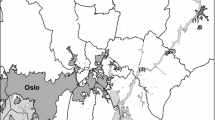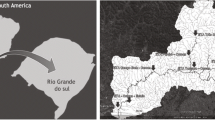Abstract
The 2015 rupture of the Fundão dam near the district of Bento Rodrigues in Mariana, Minas Gerais, Brazil, released around 50 million m3 of iron ore tailings. The first tributary of the Rio Doceto receive this waste was the Gualaxo do Norte River. Many groups in Brazil and from around the world have studied the environmental and social impacts of this disaster. However, relationships between the introduction of mining waste, the geological complexity of the area, and the presence of pathogenic organisms have not yet been investigated. The present study aimed to measure the concentrations of enteric pathogens along the Gualaxo do Norte River after the environmental disaster and to correlate their abundance with the presence of metals and semimetals coming from both mining tailings and geological sources. For this purpose, we collected water samples from 27 stations along the entire basin during a hydrological year. The concentrations of metals and semimetals measured in this study were generally within limits established by national and international legislation, except for those of iron and manganese. Positive correlations between the human adenovirus (HAdV) and arsenic, barium, iron, lead, manganese, and nickel were confirmed, allowing us to observe that there is an abundance of the potentially infectious virus present in the studied sites containing metal/semimetal concentrations. These studies indicate the importance of investigations that consider viral enteric pathogens complexed with metals and may favor the stability and prolongation of the infectivity of such pathogens in water destined for human and animal usage.




Similar content being viewed by others
References
Al-Badaii F, Shuhaimi-Othman M (2015) Water pollution and its impact on the prevalence of antibiotic-resistant E. coli and total coliform bacteria: a study of the Semenyih River, Peninsular Malaysia. Water Qual Exp Health 7:319–330
ANA or Agência Nacional de Águas (2017) Outorgas emitidas http://www3.ana.gov.br/portal/ANA/regulacao/principais-servicos/outorgas-emitidas/outorgas-emitidas. Accessed 30 June 2018
APHA or American Public Health Association, American Water Works Association, Water Environment Federation (2012) Standard methods for the examination of water and wastewater, 22nd edn. APHA, AWWA, WEF, Washington Accessed 15 June 2018
Araújo DM, Yoshida MI, Carvalho CF, Stapelfeldt F (2008) Recycling of amines present in the residues from the reverse flotation of iron ore. R Esc Minas 61:455–460
Batisteli GMB, Peres AEC (2008) Residual amine in iron ore flotation. Miner Eng 21:873–876
Bosch A, Guix S, Sano D, Pintó RM (2008) New tools for the study and direct surveillance of viral pathogens in water. Curr Opin Biotechnol 19:295–301
BRAZIL- Conselho Nacional de Meio Ambiente or CONAMA (2005) Resolução nº 357 de 18 de março de 2005 Dispõe sobre a classificação dos corpos de água e diretrizes ambientais para o seu enquadramento, bem como estabelece as condições e padrões de lançamento de efluentes, e dá outras providências. Brasília, 2012. Accessed 15 June 2018
Bu H, Meng W, Zhang Y, Wan J (2014) Relationships between land use patterns and water quality in the Taizi River basin, China. Ecol Ind 41:187–197
Calijuri ML, do Couto EDA, Santiago ADF, Camargo RDA, Silva MDFM (2012) Evaluation of the influence of natural and antrhopogenic processes on water quality in Karstic region. Water Air Soil Pollut 223:2157–2168
Chaturvedi UC, Shrivastava R, Upreti RK (2004) Viral infections and trace elements: a complex interaction. Curr Sci 87:1536–1554
Cordeiro MC, Garcia GD, Rocha AM et al (2019) Insights on the freshwater microbiomes metabolic changes associated with the world’s largest mining disaster. Sci Total Environ 654:1209–1217
Costa AT, Nalini HA, de Lena JC, Friese K, Mages M (2003) Surface water quality and sediment geochemistry in the Gualaxo do Norte basin, eastern Quadrilátero Ferrífero, Minas Gerais, Brazil. Environ Geol 45:226–235
de Vicq R, Matschullat J, Leite MGP, Nalini Júnior HA, Mendonça FPC (2015) Iron Quadrangle stream sediments, Brazil: geochemical maps and reference values. Environ Earth Sci 74:4407–4417
Deerfield DW, Carter CW, Pedersen LG (2001) Models for protein-zinc ion binding sites. II. The catalytic sites. Int J Quantum Chem 83:150–165
Di Cesare A, Eckert EM, Corno G (2016) Co-selection of antibiotic and heavy metal resistance in freshwater bacteria. J Limnol 75:59–66
Dorr JVN (1969) Physiographic, stratigraphic and structural development of the Quadrilatero Ferrífero Minas Gerais, Brazil. USGS/DNPM, Minas Gerais, Brazil
dos Reis OB (2004) Estudo preliminar sobre reciclagem das aminas utilizadas em flotação de minério de ferro. Dissertation, Federal University of Ouro Preto
Fernandes GW, Goulart FF, Ranieri BD et al (2016) Deep into the mud: ecological and socio-economic impacts of the dam breach in Mariana, Brazil. Natureza e Conservação 14:35–45
Fongaro G, Viancelli A, Magri ME et al (2014) Utility of specific biomarkers to assess safety of swine manure for biofertilizing purposes. Sci Total Environ 479–480:277–283
Fongaro G, Padilha J, Schissi CD, Nascimento MA, Bampi GB, Viancelli A, Barardi CRM (2015) Human and animal enteric virus in groundwater from deep wells, and recreational and network water. Environ Sci Pollut Res 22:20060–20066
Fongaro G, Viancelli A, Reis DA et al (2019) Mineral waste containing high levels of iron from an environmental disaster (Bento Rodrigues, Mariana, Brazil) is associated with higher titers of enteric viruses. Food Environ Virol. https://doi.org/10.1007/s12560-019-09373-5
Girones R, Ferrús MA, Alonso JL, Rodriguez-Manzano J, Calgua B, de Abreu Corrêa A, Hundesa A, Carratala A, Bofill-Mas S (2010) Molecular detection of pathogens in water—the pros and cons of molecular techniques. Water Res 44:4325–4339
Hernroth BE, Conden-Hansson A-C, Rehnstam-Holm A-S, Girones R, Allard AK (2002) Environmental factors influencing human viral pathogens and their potential indicator organisms in the blue mussel, Mytilus edulis: the first Scandinavian report. Appl Environ Microbiol 68:4523–4533
Hussein S, Ali S (2017) Water quality index for Al-Gharraf River, Southern Iraq. Egypt J Aquat Res 43:117–122
IBAMA or Instituto Brasileiro de Meio Ambiente e dos Recursos Renováveis (2015) Laudo Técnico Preliminar. http://www.ibama.gov.br/phocadownload/barragemdefundao/laudos/laudo_tecnico_preliminar_Ibama.pdf. Accessed 10 June 2018
IBAMA or Instituto Brasileiro de Meio Ambiente e dos Recursos Renováveis (2016) Relatório de vistoria. http://www.ibama.gov.br/phocadownload/barragemdefundao/relatorios/2016-05-relatorio_de_vistoria.pdf. Accessed 10 June 2018
IBGE or Instituto Mineiro de Gestão das Águas (2010) Cidades. https://cidades.ibge.gov.br/. Accessed 15 June 2018
Lacerda FM, Roeser HMP (2014) Análise geoquímica e ambiental para descrição da bacia do Rio Oratórios (MG). Geochim Brasiliensis 28:227–236
Marta-Almeida M, Mendes R, Amorim FN, Cirano M, Dias JM (2016) Fundão Dam collapse: oceanic dispersion of River Doce after the greatest Brazilian environmental accident. Mar Pollut Bull 112:359–364
Miagostovich MP, Guimarães FR, Vieira CB et al (2014) Assessment of water quality in a border region between the atlantic forest and an urbanised area in Rio de Janeiro, Brazil. Food Environ Virol 6:110–115
Moreira FWA, Leite MGP, Fujaco MAG, Mendonça FPC, Campos LP, Eskinazi-Sant’Anna EM (2016) Assessing the impacts of mining activities on zooplankton functional diversity. Acta Limnol Brasiliensia 28:e7
Nascimento LP, do Reis DA, Roeser HMP, Santiago AdF (2018) Avaliação geoquímica de metais em sistemas fluviais afetados por atividades antrópicas no Quadrilátero Ferrífero. Engenharia Sanitaria Ambiental 23:767–778
Parra RR, Pereira JC, Friese K (2007) Influência Antrópica na geoquímica de água e sedimentos do Rio Conceição, Quadrilátero Ferrífero, Minas Gerais -Brasil. Brasiliensis Geochim 21:36–49
Reis DA, Santiago AF, Nascimento LP, Oilveira E, Marques LS, Roeser HMP (2017) Influência dos fatores ambientais e antrópicos nas águas superficiais no rio Matipó, afluente do rio Doce. Revista de Gestão de Água da América Latina 14:1–15
Rodrigues ASdL, Malafaia G, Costa AT, Nalini Júnior HA (2013) Background values for chemical elements in sediments of the Gualaxo do Norte River Basin, MG, Brazil. Revista de Ciências Ambientais 7:15–32
Santolin CVA, Ciminelli VST, Nascentes CC, Windmöller CC (2015) Distribution and environmental impact evaluation of metals in sediments from the Doce River Basin, Brazil. Environ Earth Sci 74:1235–1248
Segura FR, Nunes EA, Paniz FP et al (2016) Potential risks of the residue from Samarco’s mine dam burst (Bento Rodrigues, Brazil). Environ Pollut 218:813–825
Seiler C, Berendonk TU (2012) Heavy metal driven co-selection of antibiotic resistance in soil and water bodies impacted by agriculture and aquaculture. Front Microbiol 3:1–10
SEMAD or Secretaria de Estado de Meio Ambiente e Desenvolvimento Sustentável (2015) Outorga. http://www.meioambiente.mg.gov.br/. Accessed 05 June 2018
US EPA or United States Environmental Protection Agenc US EPA https://www.epa.gov/. Accessed 04 June 2018
Acknowledgements
This study was made possible by support from the Fundação de Amparo à Pesquisa do Estado de Minas Gerais (FAPEMIG), the Conselho Nacional de Desenvolvimento Científico e Tecnológico (CNPq), the Coordenação de Aperfeiçoamento de Pessoal de Nível Superior (CAPES), and the CAPES Programa Nacional de Pós-Doutorado (CAPES-PNPD), for which we are deeply thankful. We also thank Adriana Trópia de Abreu and Hermínio Naline Júnior from the Laboratório de Geoquímica Ambiental at Federal University of Ouro Preto for the ICP analysis, as well as Fundação Gorceix.
Author information
Authors and Affiliations
Corresponding author
Rights and permissions
About this article
Cite this article
dos Reis, D.A., Fongaro, G., da Silva Lanna, M.C. et al. The Relationship Between Human Adenovirus and Metals and Semimetals in the Waters of the Rio Doce, Brazil. Arch Environ Contam Toxicol 77, 144–153 (2019). https://doi.org/10.1007/s00244-019-00625-w
Received:
Accepted:
Published:
Issue Date:
DOI: https://doi.org/10.1007/s00244-019-00625-w




